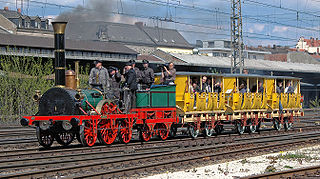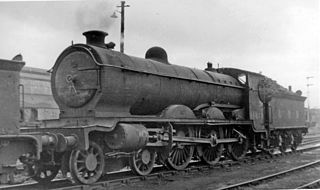
The Tanfield Railway is a 4 ft 8+1⁄2 instandard gauge heritage railway in Gateshead and County Durham, England. Running on part of a former horse-drawn colliery wooden waggonway, later rope & horse, lastly rope & loco railway. It operates preserved industrial steam locomotives. The railway operates a passenger service every Sunday, plus other days, as well as occasional demonstration coal, goods and mixed trains. The line runs 3 miles (4.8 km) between a southern terminus at East Tanfield, Durham, to a northern terminus at Sunniside, Gateshead. Another station, Andrews House, is situated near the Marley Hill engine shed. A halt also serves the historic site of the Causey Arch. The railway is "the world's oldest railway" because it runs on a section dating from 1725, other parts being in use since 1621.

The North British Locomotive Company was created in 1903 through the merger of three Glasgow locomotive manufacturing companies; Sharp, Stewart and Company, Neilson, Reid and Company and Dübs and Company, creating the largest locomotive manufacturing company in Europe and the British Empire.

Under the Whyte notation for the classification of steam locomotives, 2-2-2 represents the wheel arrangement of two leading wheels on one axle, two powered driving wheels on one axle, and two trailing wheels on one axle. The wheel arrangement both provided more stability and enabled a larger firebox than the earlier 0-2-2 and 2-2-0 types. This configuration was introduced in 1834 on Robert Stephenson's 'Patentee locomotive' but it was later popularly named Jenny Lind, after the Jenny Lind locomotive which in turn was named after the popular singer. They were also sometimes described as Singles, although this name could be used to describe any kind of locomotive with a single pair of driving wheels.

The Derby Works comprised a number of British manufacturing facilities designing and building locomotives and rolling stock in Derby, England. The first of these was a group of three maintenance sheds opened around 1840 behind Derby station. This developed into a manufacturing facility called the Midland Railway Locomotive Works, known locally as "the loco" and in 1873 manufacturing was split into locomotive and rolling stock manufacture, with rolling stock work transferred to a new facility, Derby Carriage & Wagon Works.

The Caledonian Railway 60 Class were 4-6-0 passenger engines designed by William Pickersgill and introduced in 1916. Six were built by the Caledonian Railway at its own St. Rollox works in 1916–17, and all of them passed into LMS ownership in 1923. A further twenty locomotives of a slightly modified design were built by the LMS under the auspices of George Hughes in the period of 1925–1926.

Sentinel Waggon Works Ltd was a British company based in Shrewsbury, Shropshire that made steam-powered lorries, railway locomotives, and later, diesel engined lorries, buses and locomotives.

Thomas Hill (Rotherham) Limited was a company which repaired and sold steam road vehicles, diesel and electric road vehicles and railway locomotives. It later made its name building and rebuilding diesel locomotives.

Paisley Gilmour Street railway station is the largest of the four stations serving the town of Paisley, Renfrewshire, Scotland, and acts as the town's principal railway station. The station is managed by ScotRail and serves the Ayrshire Coast Line and Inverclyde Line, 7+1⁄4 miles (11.7 km) west of Glasgow Central. The station is protected as a category B listed building.
The Glasgow, Dumfries and Carlisle Railway was a railway company in Scotland, which constructed the line from near Cumnock to Gretna Junction, forming the route from Glasgow to Carlisle via Dumfries, in association with other lines. Its promoters hoped it would form the only railway between central Scotland and England, but it lost out to rival companies.
R and W Hawthorn Ltd was a locomotive manufacturer in Newcastle upon Tyne, England, from 1817 until 1885.

Jones, Turner and Evans was a locomotive manufacturer in Newton-le-Willows, England from 1837, known as Jones and Potts between 1844 and 1852.

Sharp, Stewart and Company was a steam locomotive manufacturer, initially located in Manchester, England. The company was formed in 1843 upon the demise of Sharp, Roberts & Co.. It moved to Glasgow, Scotland, in 1888, eventually amalgamating with two other Glaswegian locomotive manufacturers to form the North British Locomotive Company.

Neilson and Company was a locomotive manufacturer in Glasgow, Scotland.
The Paisley and Renfrew railway was an early Scottish railway company that constructed and operated a line between Paisley and the River Clyde at Renfrew Wharf, enabling journeys between Glasgow and Paisley by connecting river boat. The railway was built to the track gauge of 4 ft 6 in on stone block sleepers.

The Glasgow, Paisley, Kilmarnock and Ayr Railway (GPK&AR) was a railway in Scotland that provided train services between Glasgow, Kilmarnock and Ayr. It opened its first line, between Glasgow and Ayr, in stages from 1839 to 1840. The section between Glasgow and Paisley was made jointly with the Glasgow, Paisley and Greenock Railway. Later it built a line from Dalry via Kilmarnock to Cumnock, linking there with the Glasgow, Dumfries and Carlisle Railway, and together forming a through route from Glasgow to Carlisle. The two companies merged to form the Glasgow and South Western Railway.
The Kilmarnock and Troon Railway was an early railway line in Ayrshire, Scotland. It was constructed to bring coal from pits around Kilmarnock to coastal shipping at Troon Harbour, and passengers were carried.

Dinorwic quarry is a large former slate quarry, now home to the Welsh National Slate Museum, located between the villages of Llanberis and Dinorwig in Wales. At its height at the turn of the century, it was the second largest slate quarry in Wales, after the neighbouring Penrhyn quarry near Bethesda. Dinorwic covered 700 acres (283 ha) consisting of two main quarry sections with 20 galleries in each. Extensive internal tramway systems connected the quarries using inclines to transport slate between galleries. Since its closure in 1969, the quarry has become the site of the National Slate Museum, a regular film location, and an extreme rock climbing destination.
The Largs Branch is a railway line in Scotland, serving communities on the north Ayrshire Coast, as well as the deep water ocean terminal at Hunterston. It branches from the Glasgow to Ayr line at Kilwinning.

The South African Railways Class NG6 4-4-0 of 1895 was an ex-Mozambican narrow-gauge steam locomotive from the Beira Railway era.













